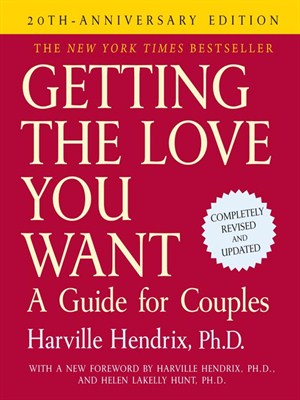
Are You Getting The Love You Crave?
One of the greatest resources for marriage and family is the book by Harvile Hendrix (Harville Hendrix, Ph.D. – ISBN 10: 0-8050-6895-3) and, in the twentieth anniversary edition, joined by his wife Helen Lakelley Hunt accurately titled “Getting The Love You Want”. This is a brief summary* aimed to get you interested enough to buy the book and use it, along with the exercises and maybe even a therapist to make your romantic relationship into the best love of your life.
SUMMARY by H. Holt & Company
One of my main realizations in Getting The Love You Want was that the two individuals in a relationship need to let go of the illusion that they are the centre of the universe and learn to see each other as equal partners. There are indeed two people in the relationship. When two individuals surrender their centrality, something unexpected occurs – the relationship itself becomes the center. Once that fundamental shift occurs, they can begin to work with the unconscious purpose of their relationship, not against it. They can begin to accept the fact that being in an intimate love relationship calls forth all the unresolved issues of their childhood, and that they can learn how to work together to resolve them. We are born in relationship, we are wounded in relationship, and we can be healed in relationship. Indeed, we cannot be fully healed outside of a relationship. This is the idea that resonated with so many couples.
- The first step is become more conscious of our old wounds. We look into the past for evidence of how we were denied adequate nurturing and how we repressed essential parts of our being. We do this through therapy, prayer, and reflection, and by becoming more astute observers of everyday events. As we gather new insights, we share them with our partners, because we no longer assume they can read our minds. When our partners share their thoughts and feelings with us, we listen with understanding and compassion, knowing that this sharing is a sacred trust. Gradually we start to “reimage” our partners, to see them as they really are wounded children seeking salvation.
- Once we have this more accurate image, we begin to redesign our relationships to heal our wounds.
“To do this, we first build an atmosphere of safety and trust. By closing our exits, renewing our commitment to each other, and deliberately pleasuring each other, we create a safe and nurturing environment.”
We add to this feeling of safety and validation by learning to communicate openly and effectively. As we overcome our resistance to this new way of relating, we begin to see our partners with even more clarity. We learn that they have fears and weaknesses and desires that they have never shared with us. We listen to their criticisms of us and realize that these illuminate our own darkness. We tell ourselves: “My partner has something to say about me. There is probably a measure of truth in this comment.” Gradually we come to accept the fullness, the dark and the light of our own being.
- The next step in the healing process is perhaps the most difficult: we make a decision to act on the information we are acquiring about ourselves and our partners and become our partner’s healers. We go against our instinct to focus on our own needs and make a conscious choice to focus on theirs. To do this, we must conquer our fear of change. As we respond to our partners’ needs, we are surprised to discover that, in healing our partners, we are slowly reclaiming parts of our own lost selves. We are integrating parts of our being that were cut off in childhood. We find ourselves regaining our capacity to think and to feel, to be sexually and spiritually alive, and to express ourselves in creative ways.
 As we reflect on all that we are learning, we see that the painful moments in life are in reality opportunities for growth. Instead of blocking the pain, we ask ourselves: “What truth is trying to emerge at this moment? What primal feelings are hiding beneath these feelings of sadness, anxiety, and frustration?” We learn that the underlying feelings are pain and rage and the fear of death, and that these feelings are common to us all. Finally, we find a safe and growth-producing way to express these powerful emotions and no longer allow them jeopardize our relationships.
As we reflect on all that we are learning, we see that the painful moments in life are in reality opportunities for growth. Instead of blocking the pain, we ask ourselves: “What truth is trying to emerge at this moment? What primal feelings are hiding beneath these feelings of sadness, anxiety, and frustration?” We learn that the underlying feelings are pain and rage and the fear of death, and that these feelings are common to us all. Finally, we find a safe and growth-producing way to express these powerful emotions and no longer allow them jeopardize our relationships.
- One by one, the elements of our marriage that were once unconscious-the fears, the anger, the childhood needs, the archaic pain-are brought to the surface, first to find acceptance, then, ultimately, to be resolved. As our wounds heal and as more hidden parts of ourselves come into our awareness, we have a new sense of our inherent unity and wholeness.
For more information on how to get the love you want contact us today!
* This brief summary was originally published by Henry Holt and Company and the entire summary can be found at: http://www.peace.ca/gettingtheloveyouwant.htm
Recent Comments